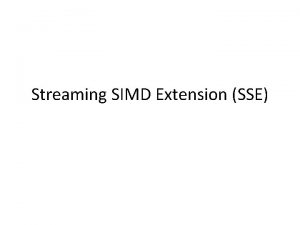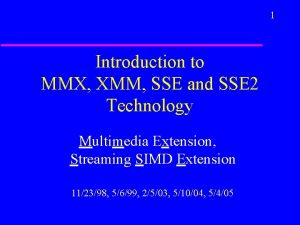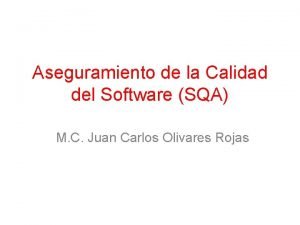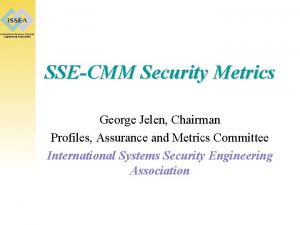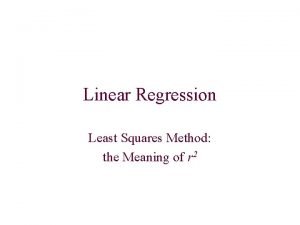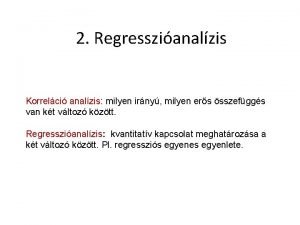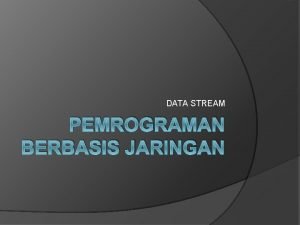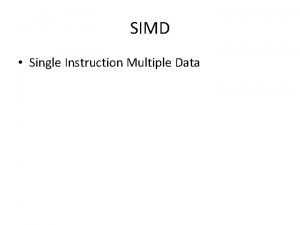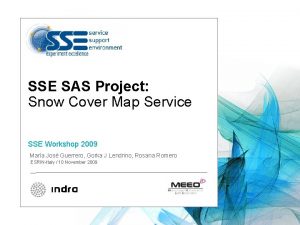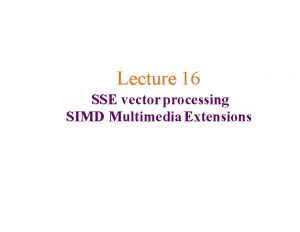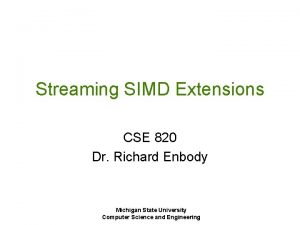Streaming SIMD Extension SSE SIMD architectures A data


















- Slides: 18

Streaming SIMD Extension (SSE)

SIMD architectures • A data parallel architecture • Applying the same instruction to many data – Save control logic – A related architecture is the vector architecture – SIMD and vector architectures offer high performance for vector operations.

Vector operations • Vector addition Z = X + Y for (i=0; i<n; i++) z[i] = x[i] + y[i]; • Vector scaling Y = a * X for(i=0; i<n; i++) y[i] = a*x[i]; • Dot product for(i=0; i<n; i++) r += x[i]*y[i];

SISD and SIMD vector operations • C = A + B – For (i=0; i<n; i++) c[i] = a[i] + b[i] A B C 9. 0 8. 0 7. 0 6. 0 5. 0 4. 0 3. 0 2. 0 1. 0 SISD + 1. 0 1. 0 A B 7. 0 5. 0 3. 0 1. 0 8. 0 6. 0 4. 0 2. 0 1. 0 SIMD + + 10 9. 0 8. 0 7. 0 6. 0 5. 0 4. 0 3. 0 2. 0 8. 0 6. 0 4. 0 2. 0 9. 0 7. 0 5. 0 3. 0 C

x 86 architecture SIMD support • Both current AMD and Intel’s x 86 processors have ISA and microarchitecture support SIMD operations. • ISA SIMD support – MMX, 3 DNow!, SSE 2, SSE 3, SSE 4, AVX • See the flag field in /proc/cpuinfo – SSE (Streaming SIMD extensions): a SIMD instruction set extension to the x 86 architecture • Instructions for operating on multiple data simultaneously (vector operations). • Micro architecture support – Many functional units – 8 128 -bit vector registers, XMM 0, XMM 1, …, XMM 7

SSE programming • Vector registers support three data types: – Integer (16 bytes, 8 shorts, 4 int, 2 long int, 1 dqword) – single precision floating point (4 floats) – double precision float point (2 doubles). [Klimovitski 2001]

SSE instructions • Assembly instructions – Data movement instructions • moving data in and out of vector registers – Arithmetic instructions • Arithmetic operation on multiple data (2 doubles, 4 floats, 16 bytes, etc) – Logical instructions • Logical operation on multiple data – Comparison instructions • Comparing multiple data – Shuffle instructions • move data around SIMD registers – Miscellaneous • Data conversion: between x 86 and SIMD registers • Cache control: vector may pollute the caches • etc

SSE instructions • Data Movement Instructions: MOVUPS - Move 128 bits of data to an SIMD register from memory or SIMD register. Unaligned. MOVAPS - Move 128 bits of data to an SIMD register from memory or SIMD register. Aligned. MOVHPS - Move 64 bits to upper bits of an SIMD register (high). MOVLPS - Move 64 bits to lower bits of an SIMD register (low). MOVHLPS - Move upper 64 bits of source register to the lower 64 bits of destination register. MOVLHPS - Move lower 64 bits of source register to the upper 64 bits of destination register. MOVMSKPS = Move sign bits of each of the 4 packed scalars to an x 86 integer register. MOVSS - Move 32 bits to an SIMD register from memory or SIMD register.

SSE instructions • Arithmetic instructions – pd: two doubles, ps: 4 floats, ss: scalar – ADD, SUB, MUL, DIV, SQRT, MAX, MIN, RCP, etc • ADDPS – add four floats, ADDSS: scalar add • Logical instructions – AND, OR, XOR, ANDN, etc • ANDPS – bitwise AND of operands • ANDNPS – bitwise AND NOT of operands • Comparison instruction: – CMPPS, CMPSS – compare operands and return all 1’s or 0’s

SSE instructions • Shuffle instructions – SHUFPS: shuffle number from one operand to another – UNPCKHPS - Unpack high order numbers to an SIMD register. Unpckhps [x 4, x 3, x 2, x 1][y 4, y 3, y 2, y 1] = [y 4, x 4, y 3, x 3] – UNPCKLPS • Other – Data conversion: CVTPS 2 PI mm, xmm/mem 64 – Cache control • MOVNTPS stores data from a SIMD floating-point register to memory, bypass cache. – State management: LDMXCSR load MXCSR status register.

SEE programming in C/C++ • Map to intrinsics – An intrinsic is a function known by the compiler that directly maps to a sequence of one or more assembly language instructions. Intrinsic functions are inherently more efficient than called functions because no calling linkage is required. – Intrinsics provides a C/C++ interface to use processor-specific enhancements – Supported by major compilers such as gcc

SSE intrinsics • Header files to access SEE intrinsics – – – #include <mmintrin. h> // MMX #include <xmmintrin. h> // SSE #include <emmintrin. h> //SSE 2 #include <pmmintrin. h> //SSE 3 #include <tmmintrin. h> //SSSE 3 #include <smmintrin. h> // SSE 4 • MMX/SSE 2 are mostly supported • SSE 4 are not well supported. • When compile, use –msse, -mmmx, -msse 2 (machine dependent code) – Some are default for gcc. • A side note: – Gcc default include path can be seen by ‘cpp –v’ – On linprog, the SSE header files are in • /usr/local/lib/gcc/x 86_64 -unknown-linux-gnu/4. 3. 2/include/

SSE intrinsics • Data types (mapped to an xmm register) – __m 128: float – __m 128 d: double – __m 128 i: integer • Data movement and initialization – _mm_load_ps, _mm_loadu_ps, _mm_load_pd, _mm_loadu_pd, etc – _mm_store_ps, … – _mm_setzero_ps

SSE intrinsics • Data types (mapped to an xmm register) – __m 128: float – __m 128 d: double – __m 128 i: integer • Data movement and initialization – _mm_load_ps, _mm_loadu_ps, _mm_load_pd, _mm_loadu_pd, etc – _mm_store_ps, … – _mm_setzero_ps – _mm_loadl_pd, _mm_loadh_pd – _mm_storel_pd, _mm_storeh_pd

SSE intrinsics • Arithemetic intrinsics: – _mm_add_ss, _mm_add_ps, … – _mm_add_pd, _mm_mul_pd • More details in the MSDN library at http: //msdn. microsoft. com/en-us/library/y 0 dh 78 ez(v=VS. 80). aspx • See ex 1. c, and sapxy. c

SSE intrinsics • Data alignment issue – Some intrinsics may require memory to be aligned to 16 bytes. • May not work when memory is not aligned. – See sapxy 1. c • Writing more generic SSE routine – Check memory alignment – Slow path may not have any performance benefit with SSE – See sapxy 2. c

Summary • Contemporary CPUs have SIMD support for vector operations – SSE is its programming interface • SSE can be accessed at high level languages through intrinsic functions. • SSE Programming needs to be very careful about memory alignments – Both for correctness and for performance.

References • Intel® 64 and IA-32 Architectures Software Developer's Manuals (volumes 2 A and 2 B). http: //www. intel. com/products/processor/manuals/ • SSE Performance Programming, http: //developer. apple. com/hardwaredrivers/ve/sse. html • Alex Klimovitski, “Using SSE and SSE 2: Misconcepts and Reality. ” Intel Developer update magazine, March 2001. • Intel SSE Tutorial : An Introduction to the SSE Instruction Set, http: //neilkemp. us/src/sse_tutorial. html#D • SSE intrinsics tutorial, http: //www. formboss. net/blog/2010/10/sseintrinsics-tutorial/ • MSDN library, MMX, SSE, and SSE 2 intrinsics: http: //msdn. microsoft. com/en-us/library/y 0 dh 78 ez(v=VS. 80). aspx
 Simd
Simd Brand leveraging strategies
Brand leveraging strategies Sse
Sse Mmx sse
Mmx sse Prof.sse
Prof.sse Sse coverage map
Sse coverage map Sse-cmm
Sse-cmm Intro to xamarin
Intro to xamarin Nersc job script generator
Nersc job script generator Ssecmm
Ssecmm Sse linear regression
Sse linear regression Trade and barter sse
Trade and barter sse Sse can never be
Sse can never be Direct control pointing devices
Direct control pointing devices Irny
Irny Meletakkan posisi yang telah ditandai dengan mark()
Meletakkan posisi yang telah ditandai dengan mark() Streaming telemetry data
Streaming telemetry data Integral vs modular architecture
Integral vs modular architecture Database storage architecture
Database storage architecture
